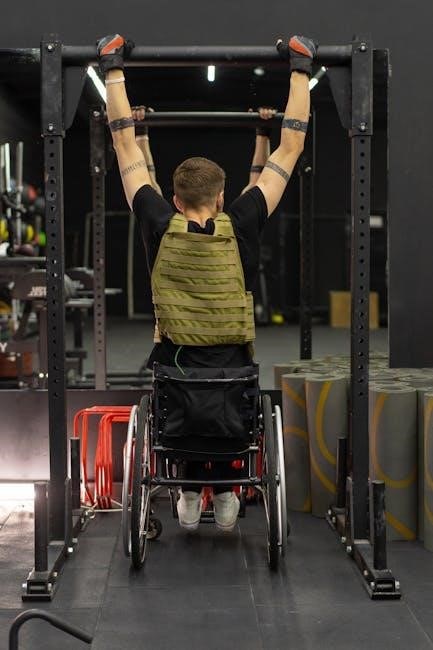pull-up training program pdf
A well-structured pull-up training program is essential for building upper body strength and achieving your first pull-up․ These programs offer progressive exercises‚ technique mastery‚ and a clear path to success‚ helping you build endurance‚ grip strength‚ and overall fitness․ Whether you’re a beginner or advanced‚ a tailored plan ensures steady progress and injury prevention‚ making pull-ups accessible and rewarding for everyone․
1․1 Importance of Pull-Ups in Strength Training
Pull-ups are a cornerstone of strength training‚ offering unparalleled benefits for building upper body strength and muscle endurance․ They engage multiple muscle groups‚ including the latissimus dorsi‚ biceps‚ and core‚ making them a highly efficient exercise․ Pull-ups improve functional strength‚ enhance posture‚ and reduce injury risk․ They also promote full-body integration‚ as they require coordination and stability․ Incorporating pull-ups into a training program fosters overall athleticism and can be scaled to suit different fitness levels‚ from beginners to advanced trainees․ Their versatility and effectiveness make them a key component of any comprehensive strength training regimen․
1․2 Benefits of a Structured Pull-Up Program
A structured pull-up program offers numerous benefits‚ including progressive overload‚ consistent improvement‚ and injury prevention․ It provides a clear roadmap‚ ensuring steady progress and avoiding plateaus․ By focusing on specific exercises and techniques‚ it enhances muscle recruitment patterns and overall strength․ A well-structured program also promotes accountability and consistency‚ key factors for achieving pull-up goals․ Additionally‚ it helps build confidence and mental resilience‚ as trainees see measurable improvements over time․ This systematic approach ensures that all aspects of pull-up performance are addressed‚ leading to sustainable and effective results․
1․3 Overview of the 10-Week Pull-Up Training Plan
The 10-week pull-up training plan is designed to progressively build strength‚ endurance‚ and technique․ It is divided into phases‚ starting with foundational exercises like inverted rows and dead hangs to develop initial strength․ As the program advances‚ it introduces assisted pull-ups and gradually reduces assistance to build independence․ The plan incorporates deload weeks for recovery and includes accessory exercises to enhance grip strength and core stability․ By week 10‚ trainees aim to perform multiple unassisted pull-ups with improved form and efficiency․ The structured approach ensures consistent progress and minimizes the risk of overtraining․

Understanding the Program Duration
Understanding the program duration ensures a tailored approach to strength development‚ allowing for steady progress and recovery․ Different plans vary from 6 to 12 weeks․
2․1 6-12 Week Pull-Up Training Plan
A 6-12 week pull-up training plan is designed to build strength progressively․ It starts with foundational exercises like assisted pull-ups and inverted rows‚ gradually increasing difficulty․ Weeks 1-4 focus on building a base with higher reps‚ while weeks 5-8 introduce weighted pull-ups and stricter form․ Weeks 9-12 emphasize unassisted pull-ups and advanced variations․ The plan ensures consistent progress‚ avoids plateaus‚ and allows for recovery․ It’s ideal for intermediates aiming to master pull-ups or increase reps․ Proper form and periodization are key to success․
2․2 7-Week Progressive Pull-Up Program
The 7-week progressive pull-up program accelerates strength development through targeted exercises․ Weeks 1-3 focus on foundational movements like inverted rows and assisted pull-ups‚ building baseline strength․ Weeks 4-6 introduce advanced techniques such as negatives and weighted reps to enhance power․ The final week emphasizes unassisted pull-ups and endurance․ This condensed plan is ideal for those with limited time‚ ensuring rapid progress․ Consistency and proper form are crucial to maximize gains and avoid injury‚ making it a popular choice for intermediate trainees seeking quick results․
2․3 9-Week Pull-Up Strength Development Plan

The 9-week pull-up strength development plan emphasizes gradual progression to build substantial strength․ Divided into three phases‚ it starts with foundational exercises like dead hangs and assisted pull-ups to improve grip and core stability․ Weeks 4-6 introduce weighted pull-ups and plyometric variations to enhance power․ The final phase focuses on high-volume sets and endurance‚ ensuring sustained progress․ This extended program allows for thorough adaptation‚ making it suitable for those seeking long-term strength gains․ Consistency and proper nutrition are key to achieving maximum results by the end of the ninth week;
2․4 12-Week Beginner-Friendly Pull-Up Program
The 12-week beginner-friendly pull-up program is designed for individuals with limited upper body strength․ It starts with foundational exercises like dead hangs and assisted pull-ups to build grip and basic strength․ Weeks 1-4 focus on inverted rows and resistance band-assisted pull-ups․ Weeks 5-8 introduce negating pull-ups and controlled descents․ By weeks 9-12‚ trainees progress to full pull-ups‚ aiming for higher reps and endurance․ This program emphasizes gradual progression‚ ensuring safety and steady improvement․ It’s ideal for those needing a slower‚ more structured approach to achieve their first pull-up․

Key Components of the Program
The program focuses on progressive overload‚ strength development‚ and technique mastery‚ ensuring balanced training and full-body engagement․ It’s designed to support all fitness levels effectively․
3․1 Weekly Structure and Progression
The program is divided into weekly blocks‚ each focusing on specific skills and strength development․ Weeks 1-2 emphasize foundational exercises like assisted pull-ups and inverted rows to build initial strength․ Weeks 3-4 introduce progressive overload‚ increasing reps or resistance․ Weeks 5-6 focus on advanced techniques‚ incorporating weighted pull-ups and plyometric variations․ Each week includes dedicated days for technique refinement‚ strength-building‚ and recovery․ The structure ensures gradual progression‚ preventing plateaus and promoting consistent improvement․ Regular assessments track progress‚ adjusting the plan as needed to maintain optimal results․
3․2 Focus on Maximum Strength Development
For maximum strength development in pull-ups‚ focus on progressive overload and resistance training․ Incorporate weighted pull-ups by adding a weighted vest or using resistance bands to increase intensity․ Aim to gradually increase the weight or reps each week to challenge muscles and promote growth․ Consistency is key; ensure each workout pushes beyond previous limits while maintaining proper form to prevent injury․ This approach not only builds muscular endurance but also enhances overall pulling power‚ essential for mastering advanced pull-up variations and achieving long-term strength goals effectively․ Stay committed and watch your strength soar!
3․3 Incorporating Core Strength Exercises
Incorporating core strength exercises is crucial for improving pull-up performance․ A strong core enhances stability and reduces unnecessary movement during pull-ups․ Focus on exercises like planks‚ hollow body holds‚ and Russian twists to target the abs and obliques․ Additionally‚ Superman holds and bird dogs can strengthen the lower back and improve posture․ These exercises help maintain a rigid body position‚ allowing for more efficient pull-ups․ Include core workouts 2-3 times per week‚ ensuring proper form to maximize effectiveness and reduce injury risk․ A strong core is the foundation for mastering pull-ups and advancing in strength training․
3․4 Grip Strength and Endurance Training
Grip strength and endurance are essential for pull-up success․ Weak grip can limit performance and lead to early fatigue․ Incorporate exercises like dead hangs‚ towel pull-ups‚ and plate pinches to build grip resilience․ Dead hangs target the entire hand and forearm‚ while towel pull-ups enhance grip endurance․ Plate pinches improve finger strength and overall grip stability․ Aim to train grip 3-4 times per week‚ gradually increasing duration or weight․ Strong grip ensures better control during pull-ups‚ reducing strain and improving overall performance․ A well-rounded grip training routine is vital for long-term progress in pull-up training․
Weekly Breakdown of the Training Plan
The 10-week program is structured to progressively build strength and endurance․ Weeks 1-2 focus on foundational exercises like assisted pull-ups and inverted rows․ Weeks 3-4 introduce weighted pull-ups and negative reps to enhance strength․ Weeks 5-6 emphasize advanced techniques and higher volume․ A deload week at Week 9 allows recovery‚ ensuring optimal progress․ Each phase is designed to align with the trainee’s fitness level‚ promoting steady improvement and avoiding plateaus․
4․1 Weeks 1 & 2: Building Foundation and Strength
Weeks 1 and 2 focus on developing foundational strength and endurance․ Trainees start with assisted pull-ups‚ inverted rows‚ and dead hangs to build grip and core stability․ The emphasis is on mastering proper form and progressively increasing volume․ For example‚ 3 sets of 8-10 assisted pull-ups and 3 sets of 10-12 inverted rows are common․ Core engagement and controlled movements are stressed to avoid injury․ This phase lays the groundwork for more advanced exercises in later weeks‚ ensuring a solid base for progress․
4․2 Weeks 3 & 4: First Pull-Up Progression
Weeks 3 and 4 introduce the first pull-up progression‚ focusing on transitioning from assisted to unassisted movements․ Trainees perform negative pull-ups‚ starting at the top and slowly lowering themselves․ Controlled descents build strength and muscle memory․ Supporting exercises like weighted rows and grip work are intensified․ The volume increases slightly‚ with 4 sets of 6-8 reps for negatives and 3 sets of 12-15 for rows․ This phase aims to develop the strength and confidence needed for the first unassisted pull-up‚ while maintaining proper form and progression․
4․3 Weeks 5 & 6: Advanced Pull-Up Progression

Weeks 5 and 6 focus on advancing pull-up proficiency with increased intensity․ Trainees perform plyometric pull-ups to build explosive strength and weighted pull-ups to enhance load tolerance․ Supporting exercises like front lever holds and archer rows are added to target the upper body and core․ The volume increases to 5 sets of 5-8 reps for weighted pull-ups and 3 sets of 10-12 for archer rows․ This phase emphasizes strength‚ control‚ and endurance‚ preparing trainees for more complex movements in later weeks while ensuring proper form is maintained․
4․4 Week 9: Deload Week for Recovery

Week 9 serves as a deload week‚ focusing on active recovery to prevent overtraining and injury․ The intensity and volume of pull-up exercises are reduced by 50%‚ allowing muscles to repair and rebuild․ Trainees perform low-intensity activities like light cardio and mobility drills․ Accessory work‚ such as core exercises and grip strengthening‚ continues but at a lower intensity․ This strategic recovery phase ensures trainees return to full training with renewed strength and motivation‚ avoiding plateaus and enhancing long-term progress in their pull-up journey․

Training Frequency and Volume
Consistency is key‚ with 3-4 pull-up-focused sessions per week․ Volume gradually increases‚ balancing intensity with recovery to avoid overtraining and promote steady progress․
5․1 Recommended Training Days Per Week
For optimal progress‚ train pull-ups 3-4 times weekly․ This frequency allows for consistent strength building without overtraining․ Dedicate 2-3 days to specific techniques like wide-grip or weighted pull-ups‚ and 1-2 days to assisted or inverted row variations․ Ensure at least one full rest day between high-intensity sessions to promote recovery․ Incorporate dynamic warm-ups before each workout to enhance performance and reduce injury risk․ Adjust the schedule based on fitness level‚ gradually increasing frequency as strength improves․ Consistency and progressive overload are key to achieving pull-up mastery․
5․2 Balancing Pull-Up Training with Other Workouts
Integrating pull-up training with other exercises requires careful planning to avoid overtraining․ Allocate specific days for pull-ups and alternate with cardio‚ lower-body‚ or mobility workouts․ For example‚ dedicate two days to pull-up-focused routines and two days to complementary exercises like squats or bench presses․ Ensure at least one or two rest days to allow muscle recovery․ Avoid overlapping high-intensity workouts on consecutive days to maintain performance․ This balanced approach prevents burnout and enhances overall fitness progression․ Prioritize consistency and listen to your body to adjust the schedule as needed․
5․3 Daily Exercise Focus for Maximum Results
To maximize results in your pull-up training‚ structure your daily workouts with a clear focus․ Dedicate mornings to skill-specific exercises like assisted pull-ups or inverted rows‚ while evenings can focus on strength-building movements such as dead hangs or weighted pull-ups․ Incorporate core and grip-strengthening exercises daily to support overall performance․ Prioritize quality over quantity‚ ensuring each repetition is performed with proper form․ Allow rest days to facilitate muscle recovery‚ using active recovery techniques like stretching or yoga to maintain mobility and readiness for upcoming sessions․
5․4 Importance of Rest and Recovery Days
Rest and recovery days are crucial for muscle growth and strength development in a pull-up training program․ They allow your muscles to repair and rebuild‚ preventing overtraining and injury․ Without adequate rest‚ your body cannot adapt to the demands of training‚ leading to plateaus or decreased performance․ Incorporate rest days to replenish energy stores and promote long-term progress․ Active recovery‚ such as stretching or yoga‚ can support mobility and relaxation without stressing the muscles․ Neglecting rest can hinder results‚ making it essential to balance training with recovery for optimal outcomes․
Exercise Variety and Progression
Incorporating diverse exercises enhances strength and engagement․ Progressive overload and variation prevent plateaus‚ ensuring continuous improvement in pull-up performance and overall fitness levels․
6․1 Inverted Rows for Building Initial Strength
Inverted rows are an excellent starting point for developing the strength needed for pull-ups․ They target the same muscle groups‚ such as the latissimus dorsi and rhomboids‚ but in a more accessible way․ Perform them by gripping a bar with your feet extended‚ pulling your chest toward the bar with controlled movement․ This exercise builds foundational strength‚ improves grip endurance‚ and prepares the body for more advanced pull-up variations․ Incorporating inverted rows into your routine ensures a strong base for progression in your pull-up training program․
6․2 Dead Hangs for Grip and Core Development
Dead hangs are a fundamental exercise in pull-up training‚ focusing on grip strength and core stability․ Hang from a pull-up bar with an overhand grip‚ engaging your core to maintain a straight line from head to heels․ Hold for 10–60 seconds‚ rest‚ and repeat for 3–5 sets․ This exercise strengthens the grip‚ forearm muscles‚ and core‚ essential for pull-up performance․ Incorporate dead hangs 2–3 times weekly to build endurance and prepare your body for more advanced movements․ Variations‚ like grip width changes‚ can enhance overall grip development․

6․3 Assisted Pull-Ups for Skill Development
Assisted pull-ups are a valuable tool for building strength and technique‚ especially for those working toward their first pull-up․ Using a resistance band or a partner to assist with the movement allows you to practice the full range of motion while reducing the required effort․ This exercise targets the latissimus dorsi‚ biceps‚ and forearm muscles‚ improving grip strength and overall pulling power․ Start with maximal assistance and gradually reduce it as you build strength․ Incorporate 3–4 sets of 6–8 reps into your routine‚ focusing on controlled movements to enhance skill development and confidence․
6․4 Weighted Pull-Ups for Advanced Training
Weighted pull-ups are an advanced progression step for those who can already perform multiple unassisted pull-ups․ By adding weight using a belt‚ vest‚ or dumbbell‚ you increase the intensity of the exercise‚ targeting the latissimus dorsi‚ rhomboids‚ and biceps․ This variation enhances muscular endurance‚ strength‚ and hypertrophy․ Start with a manageable weight and gradually increase the load as you progress․ Aim for 3–5 sets of 3–6 reps‚ focusing on controlled movements to maintain proper form and avoid injury․ Incorporating weighted pull-ups into your routine builds the foundation for mastering more complex pull-up variations․

Proper Technique and Form
Proper technique and form are essential for effective pull-up training‚ preventing injuries‚ and maximizing strength gains․ Focus on engaging your core‚ maintaining a straight line from head to heels‚ and avoiding excessive swinging․ Grip the bar firmly‚ squeeze your lats‚ and ensure full range of motion․ Practice slow‚ controlled movements to build strength and muscle endurance․ Consistent attention to form will enhance overall performance and reduce the risk of overuse injuries․

7․1 Mastery of Pull-Up Form for Efficiency
Mastery of pull-up form is critical for efficiency and effectiveness․ Start with a dead hang‚ engaging your core and squeezing your lats before pulling․ Avoid swinging or jerking movements‚ as they reduce efficiency and increase injury risk․ Focus on controlled‚ full-range-of-motion reps‚ pulling your chest to the bar and lowering slowly․ Proper form ensures targeted muscle activation‚ maximizing strength gains while minimizing wasted energy․ Consistent attention to form enhances overall performance and supports long-term progress in your pull-up training program․
7․2 Common Mistakes to Avoid
Common mistakes in pull-up training include using momentum or swinging to complete reps‚ which reduces effectiveness and increases injury risk․ Neglecting a full range of motion by not lowering fully or pulling high enough can hinder progress․ Overreliance on assistance bands without gradual reduction limits strength development․ Poor core engagement and improper grip placement are also frequent errors․ Avoid sacrificing form for higher rep counts‚ as this undermines muscle activation and efficiency․ Correcting these mistakes ensures safer‚ more productive workouts and better overall results in your pull-up training program․
7․3 Role of Core Engagement in Pull-Ups
Core engagement is critical for effective pull-ups‚ as it stabilizes the body and prevents unnecessary movement․ Activating the abs and obliques helps maintain a rigid torso‚ ensuring proper form and targeting the intended muscles․ A strong core reduces swing and keeps the body in a straight line‚ enhancing efficiency and reducing injury risk․ Proper core engagement also promotes full-body tension‚ essential for generating power and controlling the movement․ Neglecting core activation can lead to poor form and reduced strength gains‚ making it a fundamental aspect of successful pull-up training․
7․4 Full-Body Activation During Pull-Ups
Full-body activation is essential for effective pull-ups‚ as it ensures proper muscle engagement and prevents strain․ While the lats and arms are primary movers‚ the shoulders‚ core‚ and legs also play critical roles․ Engaging the scapula by squeezing the shoulder blades helps maintain proper form and prevents rounding․ The legs‚ though not actively moving‚ should remain tight to avoid swinging․ This full-body tension creates a stable‚ straight line from head to heels‚ maximizing efficiency and reducing injury risk․ It underscores the importance of treating pull-ups as a full-body movement rather than just an upper-body exercise․
Nutrition and Recovery
Proper nutrition and recovery are vital for optimal progress in a pull-up training program․ A balanced diet rich in protein‚ carbohydrates‚ and healthy fats supports muscle growth and energy․ Adequate rest‚ stretching‚ and sleep aid in muscle recovery and prevent injury‚ ensuring consistent improvement throughout the program․
8․1 Importance of Protein for Muscle Growth
Protein is essential for muscle repair and growth‚ particularly during pull-up training․ It helps rebuild muscle fibers damaged during workouts‚ promoting strength and hypertrophy․ Aim for 1․2–2․2 grams of protein per kilogram of body weight daily․ Include lean sources like chicken‚ fish‚ eggs‚ and plant-based options such as beans and legumes․ Post-workout protein intake is critical for recovery‚ while consistent daily consumption supports ongoing muscle development․ Adequate protein ensures your body can adapt to the demands of the program‚ building the strength needed for pull-ups and other exercises․
8․2 Role of Carbohydrates in Energy Production
Carbohydrates are the primary energy source for high-intensity workouts like pull-up training․ They are converted into glycogen‚ which fuels your muscles during exercises․ Without sufficient carbs‚ energy levels may drop‚ affecting performance and progress․ Focus on complex carbs from whole foods like grains‚ fruits‚ and vegetables for sustained energy․ Simple carbs can provide quick energy during workouts․ Balancing carb intake ensures steady energy levels‚ preventing fatigue and supporting optimal performance; Proper carb timing before and after workouts helps maintain energy and aids recovery‚ making them essential for your pull-up training program․
8․3 Recovery Techniques for Optimal Results
Recovery is crucial for muscle repair and strength gains in a pull-up program․ Techniques like foam rolling‚ stretching‚ and yoga improve flexibility and reduce muscle soreness․ Massage guns or manual therapy can enhance blood flow and relieve tension․ Active recovery‚ such as light swimming or cycling‚ promotes blood circulation without overexertion․ Additionally‚ compression garments and ice baths help reduce inflammation․ Prioritizing these methods ensures your body adapts to the demands of training‚ preventing overtraining and supporting consistent progress․ Recovery is as important as the workout itself for achieving pull-up goals․
8․4 Sleep and Its Impact on Strength Training
Sleep plays a vital role in strength training‚ particularly for pull-up progress․ It allows muscles to recover‚ rebuild‚ and grow stronger․ Aim for 7-9 hours of quality sleep nightly to support muscle repair and hormonal balance․ Poor sleep can hinder recovery‚ reduce performance‚ and increase injury risk․ Establishing a consistent sleep schedule and creating a relaxing bedtime routine can enhance sleep quality․ Prioritizing sleep ensures your body is ready to tackle the demands of your pull-up training program‚ making it essential for achieving your strength and fitness goals․
Tracking Progress and Motivation
Monitor your pull-up journey by logging workouts‚ celebrating milestones‚ and staying consistent․ Motivation grows with visible progress‚ keeping you driven to achieve your strength goals․
9․1 Weekly Progress Tracking
Tracking your progress weekly is essential for staying motivated and adjusting your pull-up training program․ Log the number of pull-ups‚ reps‚ and weights used‚ and note improvements in technique․ Use a workout journal or mobile app to monitor consistency and gains․ Take progress photos or videos to visually track changes in strength and form․ Reviewing weekly progress helps identify areas for improvement and ensures you’re on track to meet your goals․ Celebrate small victories to stay motivated and committed to your pull-up journey․
9․2 Setting Realistic Goals and Celebrating Milestones
Setting realistic goals is crucial for maintaining motivation in your pull-up training program․ Break down your long-term objectives into smaller‚ achievable milestones‚ such as increasing your pull-up count or mastering a new variation․ Celebrate each milestone to reinforce progress and stay motivated․ Recognizing accomplishments‚ no matter how small‚ builds confidence and encourages consistency․ Adjust your goals as you progress‚ ensuring they remain challenging yet attainable․ This structured approach helps maintain focus and fosters a sense of achievement throughout your training journey․
9․3 Staying Motivated Throughout the Program
Staying motivated during a pull-up training program requires consistent encouragement and positive reinforcement․ Celebrate small victories‚ like increasing reps or improving form‚ to maintain enthusiasm․ Use visual reminders‚ such as progress photos or motivational quotes‚ to keep your goals in focus․ Track your progress weekly to see improvements‚ which can be a powerful motivator․ Surround yourself with supportive people or join a fitness community for accountability․ Remind yourself why you started‚ and embrace the journey as a process of growth and self-improvement․ Motivation is key to overcoming challenges and achieving success․
9․4 Importance of Community Support
Community support plays a vital role in maintaining motivation and consistency during a pull-up training program․ Training with like-minded individuals fosters accountability and encourages healthy competition․ Sharing tips‚ successes‚ and challenges with a group creates a sense of belonging and reduces feelings of isolation․ Celebrating milestones together boosts morale and reinforces commitment to the program․ A supportive community provides emotional upliftment‚ helping participants stay dedicated even during tough moments․ Surrounding yourself with others who understand your journey can significantly enhance your progress and overall experience‚ making the program more enjoyable and rewarding․
